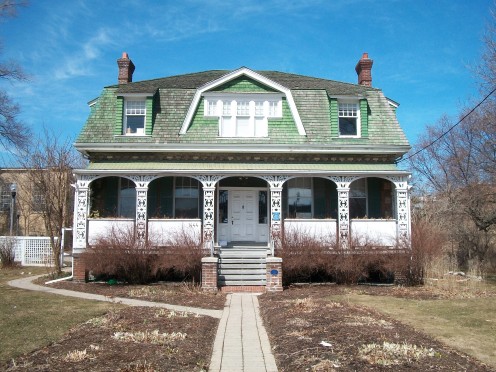Visiting Ashbridge's neighbourhood, Toronto, Ontario: remembering an old Provincial family linked with their Estate




Over 200 years of presence at their Ontario estate
The Ashbridges, an old Ontario family, lived at their estate in what is now Toronto for over 200 years. This is somewhat of a record.
Some history
While the Ashbridge family's historic property on Queen Street, East, in what is sometimes referred to as the Ashbridge's Neighbourhood, close to Leslieville, dates from the 19th century, the family's presence at the estate which bears their name dates from the 1790s.
Not a few other old Ontario families, whose presence in the early years of European settlement in what is now the Greater Toronto Area significantly influenced the landscape, came to Upper Canada from Pennsylvania. Such families included the Stongs (often remembered at Black Creek Pioneer Village) and the Riesers (remembered in a monument at the junction of Reesor Road and Highway 7), and the Ashbridges were no exception.
Sarah Ashbridge and family started clearing land around the location of the present Estate in 1794. A nearby road is named for Sarah Ashbridge, and other members of the family also have roads in the neighbourhood named for them. The family estate is also the origin of the name of Ashbridge's Bay, along the nearby Ontario Lakeshore.
The present house, around which the Estate was centred, was built in 1854, and is sometimes referred to as Jesse Ashbridge House. Its architect was Joseph Sheard (who also served as Mayor of Toronto). The house's upper storey was added in 1899. The house is noted for its pillar carvings on its front porch.
The house was occupied by one member of the Ashbridge family or another until the year 1997. Some Ontario properties qualify as Century Farmhouses. By the same token, I think the Ashbridge property would thus qualify for any designation such as Bicentennial Estate, or some such term, were it widespread.
The house, its surrounding gardens and its Ontario Heritage Trust information panel may be viewed to good effect from the sidewalk at 1444 Queen Street East, near this road's junction with Coxwell Avenue. The house is used as the offices of the Ontario Society of Artists and of the Ontario Archaeological Society.
Former estate larger than the current Principality of Monaco
While even today the house is gracefully set in herbaceous acreage (a little more than 8000 square metres), the Estate formerly comprised 2.4 square kilometres of land. When for example one recalls that the current Principality of Monaco contains 1.98 square kilometres of land, this puts into some perspective the size of the former Estate which the Ashbridge family, as prosperous farmers, occupied.
Prosperous farm properties of this size were not, in fact, necessarily so unusual, except that when one remembers that a sizable proportion of Toronto's East End occupies what was once the Ashbridge Estate, then one will appreciate just how much of the urban landscape was derived from this historic property.
Also worth seeing
The visitor attractions and cultural sites of the Greater Toronto Area are far too numerous to summarize adequately here. But a few noted properties on Queen Street East and to the east of the city include the following:
Metropolitan United Church (distance: 6.1 kilometres), also on Queen Street East, approaching the Downtown area, this High Victorian Gothic building was completed in 1872.
The Thomson Settlement and Scarborough Historical Museum (distance: 13.9 kilometres) situated in the Thomson Memorial Park, Scarborough, comprises Cornell House and the McCowan Log House.
Erskine Church , Pickering (distance: 40.7 kilometres); this historic church dates from 1854.
...
How to get there: Air Canada, flies to Toronto Pearson Airport, with wide North American and other connections, from where car rental is available. (Distance from Toronto Pearson Airport to 1444 Queen Street East: 33.9 kilometres). However, visitors may prefer to use the TTC streetcar service No. 501 from Downtown Toronto, which passes directly in front of the Ashbridge Estate. Please note that some facilities may be withdrawn without notice. Please check with the airline or your travel agent for up to date information.
MJFenn is an independent travel writer based in Ontario, Canada.
Other of my hubpages may be of interest
- Visiting Ontario's Ajax: Rural Gothic Revival architecture, at Post Hill House
This rather pleasing house at 132 Kingston Road West is the sole surviving example in Ontario's Town of Ajax of Rural Gothic Revival. 19th century background 'Rural' it certainly was in what is now... - Visiting Ontario's Parkwood, at Oshawa: memories of a Canadian automobile tycoon
It would be a misconception to assume that Colonel R. S. ('Sam') McLaughlin was an isolated figure in Oshawa's burgeoning automobile industry. In fact, Sam McLaughlin and his brother George followed their... - Visiting Ontario's historic Erskine Church: memories of 19th century Pickering
In Dunbarton, in the Durham Region's Pickering, the Erskine Church serves as a link of continuity with the city's past. 19th century origins Already by 1954, the church building's centenary was being... - Visiting the City of Vaughan's belltower landmark at Thornhill West, Ontario: echoes of a harmonious
Some parts of the world are particularly endowed with belfries, or belltowers. Flanders, for example, has, since the Middle Ages been noted for its tradition of building belfries near the centre of towns; part... - Visiting the Arctic Watershed near Northern Ontario's Kenogami Lake: historical boundary of Rupert's
In the course of my travels, I have on a number of occasions passed a boundary in Canada, which lies to the north of Kenogami Lake, ON, in the Timiskaming District. The boundary in question is known as the... - Visiting New York's Broderick Park, Buffalo: poignant memories of the Underground Railroad
On Squaw Island, within the City of Buffalo, New York, is the now tranquil and scenic Broderick Park, but replete with poignant memories of the Underground Railroad. Some history This...









